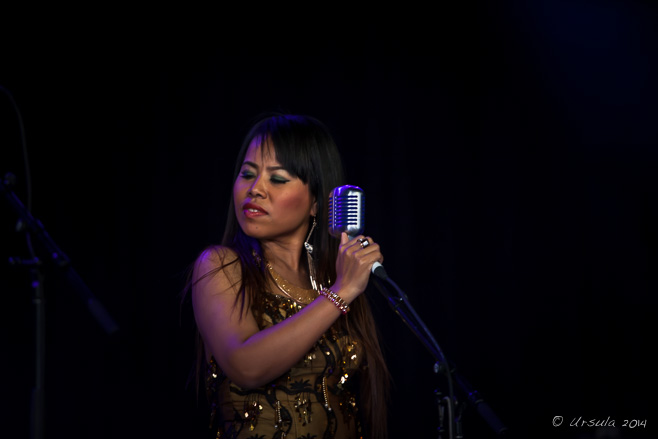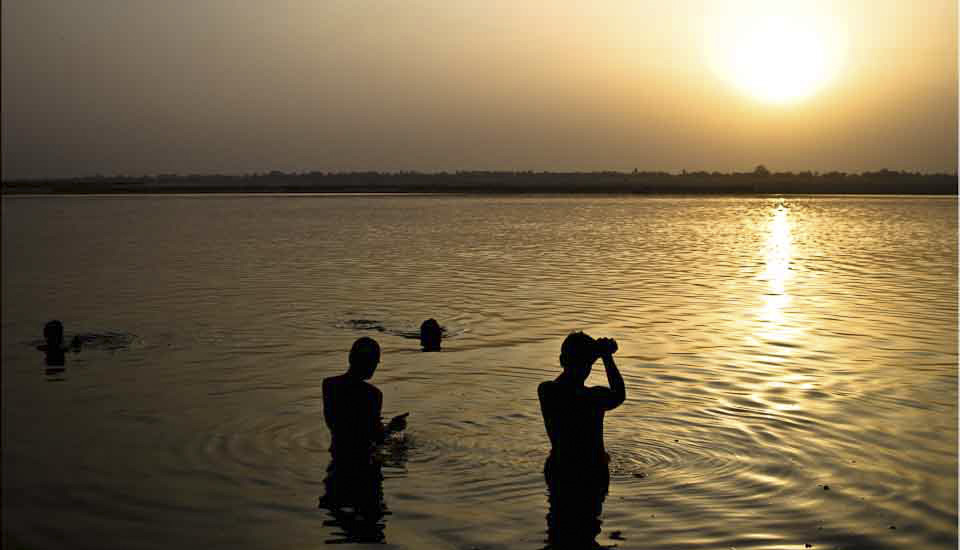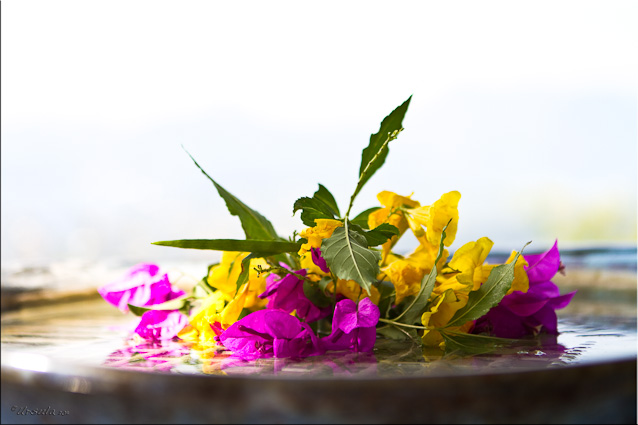 Srey Channthy
Powerful vocals; heartbreaking stories…
(Double click for: Whiskey Cambodia, from the album of the same name by The Cambodian Space Project)
A female chanteuse in long hair and short skirt is dwarfed by the stage until she opens her mouth. Her vocals wail across Asian half-notes – off the scale and back again – to a back-beat of pounding music ranging from Khmer pop, to psychedelic rock, and beyond. It was easy to imagine oneself in a dark, smoky bar in Phnom Penh, circa late 1960s. The room would be filled with mostly white, male patrons: world-weary foreign correspondents, hard-drinking army personnel on R&R from the war in neighbouring Vietnam, and expat French businessmen left over from the colonial days.
But, no, I wasn’t in Phnom Penh. I was at the Crossroads Stage at Bluesfest 2014 on a hot Sunday afternoon in Australia’s Byron Bay, and The Cambodian Space Project was filling the room with sound. Billed by the festival organisers as an “Asian Rock ‘n’ Roll space odyssey”, they were on my “not-to-be-missed” list.
 Srey Thy (Channthy) and The Cambodian Space Project Under the Pol Pot rule of Cambodia between 1975 and 1979, anyone deemed an “intellectual” was targeted. Over 17,000 Cambodian people were executed in the Killing Fields, and these included most of the country’s writers, artists and musicians. As a consequence, the country’s musical, artistic and literary traditions were as good as wiped out.
Srey Thy was born as part of the baby-boom that followed the Vietnamese liberation of Cambodia from Pol Pot’s horrendous rule. She grew up in a poor, rural region, working hard from a young age, and inheriting her mother’s love of singing.
According to the band’s bio, Julien Poulson, a musician from Tasmania with a grant to work on a project aimed at reviving Cambodia’s lost musical traditions, first heard Srey sing in a karaoke bar in Phnom Penh in 2009. He persuaded her to join him, and together they are the nucleus of The Cambodian Space Project.
Srey Thy is firmly grounded in her rural roots, and the band regularly plays in remote villages across Cambodia. Srey recalls their first visit to her home village in her song: Whiskey Cambodia. With a cheeky smile, broken English and sparkling eyes, she told the Byron Bay audience that the villagers were worried because they had “no red wine” for the foreigners, and the guests would have to make do with “whiskey Cambodia” – which, I can attest, is an extremely potent brew.
 Srey Channthy  Julien Poulson  Srey Channthy  Singing the Songs of the Past
The band’s repertoire includes Khmer-pop songs made famous by singer-songwriter Pan Ron, who was at the height of popularity in the 1960s and early 1970s, before being killed in 1975 by the Khmer Rouge in one of their final mass-executions.  Romantic Ballads
The set also included songs popularised between 1967 and 1975 by Ros Serey Sothea. Known as “the golden voice of the royal capital,” she is also thought to have been killed by the Khmer Rouge. 
The songs were all in Khmer (although one was at least partially sung in French – a remnant from the days of colonial rule), and the explanations of the titles were almost as much fun as the music: my favourite is “Cut your Beard (I love you)”.
 The Cambodian Space Project (CSP)
Monday evening, against a backdrop of stars, the group took to the Delta Stage to once again woo and wow the audience.  The Chanteuse
I was as captivated by Srey’s songs and story-telling as I had been the day before.  Stars in our Eyes
Srey was born and raised in one of the poorest regions of Cambodia. She learned to sing from her mother, who survive the Khmer Rouge purges by disguising herself as a peasant boy.  Twist and Dance
One minute I was reminded of the go-go dancers who graced the clubs and television sets of the late sixties; the next minute Srey incorporated elegant traditional Khmer dance moves. 
 Power and Pain
Srey is at her most powerful on CSP original works, like the lament: “The Boat”, a hauntingly beautiful song about asylum seekers trying to make their way to Australia. She had me in tears. More than once.
I’m sure part of that is my deep attachment to her homeland, and a small sense of the pain that is there. What an achievement it is to rise above it, and turn that pain into music! Music that commemorates those murdered Cambodian singers of the past and music that also tells stories of today: “positive and powerful stories”.

For Srey Thy is not just a stage presence with an enormous voice; she is a human rights advocate and a songwriter working for a better future.
For herself, and for her country.
Impressive.
Pictures: 20-21April2014
(On a tragic note: Srey Channthy was killed on 20 March 2018 when the tuk-tuk in which she was a passenger was hit by a car. She is greatly missed.)
Posted in Music,PortraitsTags: biography,blog,Byron Bay Bluesfest,environmental portrait,people,performance,performers,Photo Blog,portrait,portraits,Travel Blog,Ursula Wall
 Stage Lights
Sound and people fill the large marquees; sometimes the performers seem to be a long way away. Bluesfest 2014, Byron Bay. This year, the Easter long weekend marked the 25th anniversary of the annual Byron Bay Bluesfest.
We were ready!
Thanks to glorious, sunny, Autumn weather, we were able to leave our rain-coats and gumboots in the car – along with the folding chairs the organisers had rendered superfluous – as we made our way through the ticketing and security checkpoints onto Tyagarah Tee Tree Farm, not far from the famous beachside town of Byron Bay.
We had so enjoyed our three-day pass last year (Singing the Blues) that we had signed on for the full five days, thinking that if it all got too much, we could take time out. Which, of course, we didn’t. For the most part, we arrived as bands were tuning up, and left long after the cold nights had fallen. While I didn’t catch all of the 107 artists who performed across the seven stages, I made a pretty good try of seeing a lot of them – several more than once.
After five days of bouncing around, shoulder-to-shoulder with a mass of other excited music fans, I had sore legs and feet, a happy heart, and flash-cards full of more than 2000 images. Of course, attempts at shooting moving-objects-at-a-distance-in-low-light-while-dancing resulted in a lot of blurry and/or noisy and/or out-of-focus pictures destined for the scrap-heap, and it is taking me forever to go through them.
For now, at the risk of sounding like a name-dropper, I’ll share a selection of shots from the first two days.
Enjoy!
 Tijuana Cartel
Although the sun was shining brightly when we arrived Thursday afternoon, it was already dark at the stage ends of the massive Crossroads marquee where drums, …  Tijuana Cartel
… keyboard and guitar beat out Mexican rhythms.  Hats and Heads
There was a buzz of excitement in the air, and already a lot of people around. The trick was finding a spot with a view!  Arakwal Opening Ceremony
As is befitting any function held on Traditional Lands, one of the first events payed homage to the Indigenous people of the area. Festival Director Peter Noble introduces the Arakwal performers and elders.  Black Sorrows
Joe Camilleri on saxophone with Garland Jeffreys performing guest vocals.  Food Court
There was plenty of choice at the various food stalls at the food court and scattered around the festival site. I ate my way through a variety of tasty cuisines.  Lantern Parade
Oversized characters from children’s books weave through the night crowds.  Charlie Musselwhite
Legendary. Just legendary!  Charlie Musselwhite Band  Dr John and the Nite Trippers
Billed as playing “voodoo-funk, creole blues”, the 73 year old Dr John is also the model for my favourite muppet.  Dr John on Guitar
No wonder they call it “psychedelic rock”: that inimitable voice and his crazy, rambling lyrics… trippy indeed.  John Mayer on the Livescreen
We stopped at the Mojo Tent on our way out Thursday evening to catch a bit of John Mayer‘s awesome guitar (and uncomfortable patter) before heading home to recharge our batteries – literal and figurative.  Daniel Champagne
People were already pushed into the tiny Juke Joint when we arrived shortly after noon Friday. Daniel Champagne‘s prodigious guitar-playing got our day off to a wonderful start.  Cavanbah
Suzanne Vega clearly had more draw-power than the tiny venue allocated to her allowed for. I had been looking forward to her performance, but sadly, missed out.  Beth Hart
It was a day of power-house women…  Beth Hart
…and this woman is truly a force to be reckoned with. What a voice! I had goosebumps.  Beth Hart and PJ Barth
It is always a joy to watch good performers having fun.  Camera Operator
Bluesfest performances are recorded; many of the clips (authorised and otherwise) are already available on-line.  Joss Stone
Another young powerhouse: soaring vocals, heartfelt lyrics and charming chatter – Joss Stone delivers.  Buddy Guy
“Heaven is lying at Buddy Guy’s feet while listening to him play the guitar.”
– Jimi Hendrix
So, what do you call it when the 77 year-old Buddy Guy shows off his Jimi Hendrix licks? Beyond heaven.  Boz Scaggs
Boz took me back to Silk Degrees, one of the few albums I owned as a teenager, …  Boz Scaggs’ Guitar (Livescreen)
… as well as putting his distinctive stamp on classic songs and some new compositions.  The Doobie Brothers
Even those in the packed audience who were presumably too young to remember the string of Doobie Brothers‘ hits from the 70s were up and dancing in the aisles.  The Doobie Brothers
Although they are all over 60, they haven’t lost a beat.  Duelling Guitars
Patrick Simmons and John McFee playing complementary guitars.  The Doobie Brothers Livescreen
The Livescreens outside the marquee allow the participants camped out on blankets on the grass to watch the performance against the cold night sky…  Night Lights
… or to watch the crowds and the livescreens inside. I was smiling to overflowing.

From being introduced to performers I didn’t know, both local and international, through meeting timeless legends from before my time, and ultimately revisiting the sounds of my youth, it was a brilliant couple of days.
That wasn’t the end of our festival – or even the end of our night (more on that some other time) – but what a high!
There is just nothing like music.
Keep smiling!
Pictures: 17-18April2014
Posted in Australia,Culture,Music,PortraitsTags: Australia,environmental portrait,environmental portraits,music,musicians,people,performance,performers,Photo Blog,portrait,portraits,Ursula Wall
 Flowers for Peace
Hellfire Pass Memorial Museum, Kanchanaburi (Photo: 29/12/2010) It is ANZAC Day today.
ANZAC Day is the official “Remembrance Day” for Australians and New Zealanders. First observed in 1916, it started as a tribute to the Australia New Zealand Army Corps (the ANZACs) on the anniversary of their landing on the beaches of Gallipoli in Turkey on April 25th, 1915 during World War I. It is said that as many as 650 ANZACs died that day, with about 2000 casualties – and a legend was born.
Today the meaning of ANZAC, while not entirely uncontroversial, has come to include all Australian and New Zealand service personnel. According to official Australian Army documents, ANZAC Day is celebrated “all over the two nations and wherever Australians are overseas. It is our day – a day to remember with affection the courage of people and the value of friendship – to honour the dead and to acknowledge those who suffer still from the effects of war. We do not celebrate victory or glorify war – we celebrate the human spirit – the spirit of ANZAC.”
 “His duty fearlessly and nobly done – ever remembered.” I am no fan of war. But, I take no issue with paying respect to those who serve their countries and who either come back changed, or don’t come back at all. I have no doubt that many who serve do NOT live up to the stereotypes that are bandied about as part of the the ANZAC myth: courage, endurance, irreverent good humour and egalitarian mateship. But then, until we are under the same pressure, none of us knows how we might behave.
“I have a conviction that it’s only when you are put at full stretch that you can realise your full potential”
– Sir Edward (Weary) Dunlop
Thailand was caught in the middle of World War II. In a bid to retain some independence, the Thai government allowed Japan ‘safe passage’ in the country. In practice, this meant that the Japanese stationed 150,000 troops on Thai soil and were able to force the building of their proposed supply line to Burma: the infamous “Death Railway”. About twenty-two thousand Australians were captured defending British territories in Asia and 13000 of these were among the 180,000 conscripted Asian labourers and 60,000 Allied Prisoners of War (POWs) transported to Burma and Thailand to work on the 420 kilometre Burma–Thailand Railway.
 Kanchanaburi Allied War Cemetery (Photo: 09/02/2008)  “In honoured remembrance of the fortitude and sacrifice…”
Kanchanaburi Allied War Cemetery (Photos: 26/12/2010) The brutal conditions under which the railway was built cost 90,000 Asian labourers and 16,000 Allied POWs (including 2,815 Australians) their lives. Almost 9000 of these are interred in beautifully maintained cemeteries in Kanchanaburi where people can visit and pay tribute.
 Life Among the Headstones
Kanchanaburi Allied War Cemetery (photo: 26/12/2010) It is somewhat ironic that the most notorious stretch of railway was started on ANZAC Day in 1943. The Japanese were running out of time, and this, coupled with the difficulties of the sheer expanse of rock to cut through, the remoteness of the area and the lack of proper tools, led to unimaginable conditions and a horrendous loss of life.
For twelve weeks in tropical summer heat, POWs worked 12-18 hour shifts to build a 17 metre deep and 110-m long cutting through solid limestone and quartz using eight-pound hammers, steel tap drills, explosives, pinch bars, picks, shovels, hoes and bare hands. Work continued through the night, and the combination of the noise, the heat, the light from fires, bamboo torches and carbide lamps, gave rise to the name: Hellfire Pass (Thai: ช่องเขาขาด, Chong Khao Khart; Japanese: “Konyu Cutting”).
 Jungle Vines
Looking To The Tennasarim Mountains (Photo: 12/09/2009)  “… to all the men and women who suffered and died…”
HellFire Pass Memorial Museum (Photo: 29/12/2010)  The Descent into Hell …
… is much easier these days, thanks to the modern Australian Walkway. (Photos: 12/09/2009) The beautifully laid out and maintained Hellfire Pass Memorial Museum, co-sponsored by the Australian and Thai governments, and managed by the Office of Australian War Graves, sits at the top of Hellfire Pass. Complete with air-conditioning, quiet, and clean toilets, it is a far cry from what the POWs endured. A wooden staircase takes you down into the Hellfire Cutting area. An area of the cutting has been cleared and one section of track from the original rails and sleepers has been relaid by Australian forces.
 Konyu Cutting
Short section of track, recovered in 1989 and relaid in 2006. (Photo: 26/09/2010)  Tribute to those who built the Thai-Burma Railway (Photo: 12/09/2009) Against the odds, in spite of starvation, malnutrition, beriberi, pellagra, dysentery, malaria, overwork and beatings, many men survived. One of the best known Australian survivors was a Captain in the Royal Australian Army Medical Corps (R.A.A.M.C.), surgeon Ernest Edward Dunlop. In true Australian fashion, he was nicknamed ‘Weary’ – a pun on ‘Dunlop’, the makers of tyres/tires, and ‘tired’.
 Rusty Railway Spikes and Ties
(Photo: 12/09/2009)  Iron Spike, Railway Tie, Balsa Crosses and Poppies for Remembrance  Australian Flag and Remembrance Poppies, Hellfire Pass
(Photo: 27/12/2010) When Weary’s hospital in Bandoeng, Java, was captured by the Japanese, he was amongst the first men to be sent to Thailand to look after his ‘work crew’ of over one thousand men (‘Dunlop Force’ or ‘Dunlop’s Thousand’). He was a true representative of ‘the ANZAC spirit’, and his ingenuity, bravery, and leadership skills were lauded by all he met, even his Japanese captors. Dunlop was tortured and beaten on numerous occasions, but never stopped behaving with dignity. After the war, said: ‘We must forgive but never forget’.
 Memorial for Sir Edward “Weary” Dunlop
(12 July 1907- 12th July 1993) (Photo: 12/09/2009) Weary Dunlop survived the war and returned to Australia where he married his sweetheart, raised two sons, continued a distinguished medical career, was knighted, became Australian of the Year and an honorary member of the Returned and Services League, and was an exemplar of Buddhist forgiveness. He died July 1993. His ashes were spread at Hellfire Pass on ANZAC Day the next year.
 Red Poppies for Remembrance; Koala for Australia (Photo: 27/12/2010)  Koala and Flowers for the POWs  End of the Track: Hellfire Pass Another survivor of the Death Railway was Peter Rushforth, who returned to Australia to become an internationally recognised potter, and whose “Peace Vessel” has pride of place at the HellFire Pass Memorial Museum.
 “Peace Vessel” by Peter Rushforth
The endless jungle and the Tennasarim Mountains bordering Myanmar in the background, Kanchanaburi Province. (Photo:12/09/2009) “My three and a half years as a POW influenced me in developing work related to art and the humanities,” says Peter. “The Peace Vessel emphasises the positive values of life where war once raged.”

It looks like there is no end in sight to war. Let us hope we can at least behave with dignity in the face of conflict.
(The original post was written and scheduled for ANZAC Day 2011. Reposted, with slight modifications, 25April2014.)
Posted in Australia,History,Memorial,Museum,Thailand,TravelTags: ANZAC,armed forces,Australia,australian,biography,blog,Kanchanaburi,museum,nature,people,Photo Blog,thai,Thailand,travel,Travel Blog,Ursula Wall,war,WWII
 Through the Trees
A walk around the Wild Pacific Trail, Ucluelet provides great views over the rocky coast and wild water. The west coast of Vancouver Island is known for it’s wild storms.
“Storm watching” features strongly in all the tourism literature from the area – it might be one of the very few times a person could be less than happy about beautiful weather.
And we did have beautiful weather the day we stopped into the little district municipality of Ucluelet, BC, at the southern-most edge of the Pacific Rim National Park. We were on our way back to Nanaimo, along Highway 4, but had enough time for lunch and a short walk around the magnificent headland.
 Amphitrite Point Lighthouse
An easy 2.6 kilometre walking loop starts and finishes near the light station, named after the British Royal Navy ship HMS Amphitrite, a Bombay-built gunship stationed in British Columbia in the 1850s.  Looking West
The waters are tame today – but in winter, the coast can be pounded by thirty to fifty-foot waves, originating off the coast of Japan.  Memorial Bench
Benches are scattered all around the walking loop, so there is plenty of opportunity to watch the waves and wildlife. Whales are regular visitors, though we didn’t see any on our circuit.  Nature’s Artworks: Tree Stump
The walk is rich in texture and colour.  Twisted Trunks
Trees have responded to the wild winds and weather this coast is known for by twisting into fabulous shapes.  Horse Tails
The area gets an average of three metres (120 inches) of rain annually, making the forest undergrowth lush and green.  Moss and Ferns
The damp of the temperate rainforest is the perfect climate for rich mosses and ferns.  Forest Fruit
Delicate fruit and flowers provide colour contrast against the greens.  Squirrel
Although the pamphlet warns that walkers might come across bears, cougars or wolves, the biggest creature we spotted was this squirrel.  Old Plank Road
Hundred-year-old-remnants from the old elevated plank roadway that used to provide access to the lighthouse, are slowly sinking back into the land.  Old Stump  Western Red Cedar
Much of the Island’s forest cover is classed as “Mature”; that is, over 140 years old. Giant Pacific red cedar are everywhere.  Over the Waterways
The scenic views stretch in every direction.  Tiny Islands  Down to the Water
Bald eagles (none of which I caught on camera) soared overhead.  Spanish Moss  Amphitrite Point Lighthouse
Before we know it, we are back at the lighthouse and it is time to return to the car.  Black Bear
Once we were back on the road, we finally spotted an American black bear, ambling off, into the woods. 
It’s a short and easy hike along the well-maintained trail. The stunning ocean views and peaceful sections through ancient forests made it a worthwhile ramble.
And of course, the fresh ocean air helped pique our appetites for lunch in the local cafes before we headed back to the Island’s east coast.
Happy Rambles!
Pictures: 10July2013
 Girl at the Doorway
Proud and self-possessed, a young “untouchable” stands at the doorway of her simple home. There is something disturbing about having more valuable belongings in your travel bag than a whole village has within it’s boundaries.
This tension is inherent in travelling, particularly in photo-touring, in countries where wealth is poorly distributed. Although visiting under-developed areas – particularly with responsible operators – puts some much-needed cash into the local communities, it can still highlight huge disparities of income and opportunity.
This was brought home to me many years ago when I visited Fiji with my young children. They had saved up their birthday- and pocket-money, and had bought themselves new electronic games at duty-free while we were in transit. When we visited a remote Fijian village, accessible only by boat, I watched the children there playing in a dirt patch with coconut half-shells as their only toys. We had more “goods” in our holiday bungalow than these children had in their homes.
I recalled this experience when I was in the Thar Desert in Rajasthan last November. I was staying in the rather luxurious Manvar Desert Camp & Resort, Dechu, with photographer Karl Grobl, Rajasthani guide DV, and a small group of photo-enthusiasts. As it turned out, our tented accommodation, complete with electric heating, flushing toilets, and hot-and-cold water, stood in rather stark contrast to the local villages nearby.
 Manvar Desert Camp
As we bump over dusty, desert roads, the tented resort where we will be staying comes into view.  Tents in the Desert
Set amid desert shrubs and grasses …  Manvar Desert Tent
… the tents are airy, roomy, and comfortable.  Wooden Camel
It is the little touches that make a room a “home”.  Jeeps in the Desert
After settling into our tents, we head out across the bumpy dirt tracks again…  Desert Village
… stopping at a local village in the middle of the desert to visit.  Kids at the Fence
The village children collect at the gates of the houses to have a look at the visitors.  Village Kids
After working up their nerve, the boys come out to stare.  Long Walk
Other people pay us no mind as they go about their daily business.  Young Girl in her Finery  Looking after Baby
A young girl looks after a toddler, who is marked as a Hindu by the tika on the forehead, and protected against being cursed by kohl around the eyes.  Old Man in the Courtyard
In the well-swept courtyard of one of the homes, more young children gather around an elderly man.  Village Elder
His regal bearing belies his “untouchable” background.  On the Wall
Pots and utensils nestle into outdoor shelving.  Tilling Sand?
It is hard to believe that anything is going to grow in the neatly tilled rows of sand.  Kids and Carers
There is no shortage of children in the village.  Woman in her Courtyard
Bangles and other jewellery items are a local wealth-indicator.  Family
A woman poses with two of her children – almost a generation apart.  Getting Water
Clay jars of water sit in the courtyards for anyone who wants some.  Every Village Needs a Cow  Keeper of the Keys  Another Baby  The Village Well  Bringing Home the Goats
As the afternoon draws on, the young boys race home with the goats…  Bringing Home the Goats
… and the girls, with their young charges, watch.  Into the Sunset
We pile back into our jeeps, and drive into the lowering sun …  Desert Sunset
… arriving back at camp in time to watch the red sun set into the desert shrubbery.  Night Tents
Our tents are lit and waiting. I do think it is hugely important to travel with responsible operators who help local communities develop according to their own priorities.

And, it is necessary to visit with open eyes and respect.
But, there is still that tension.
‘Till next time, Namaste.
09November2013
Posted in Every Day Life,India,Portraits,RuralTags: animals,architecture,blog,children,environmental portrait,environmental portraits,nature,people,Photo Blog,portrait,portraits,travel,Travel Blog,Ursula Wall
« Older posts
Newer posts »
|








































































































































Wow, Ursula, I had no idea!
I’ve been a fan of Cambodian Space Project, Dengue Fever and many of the pre Pol Pot rock and roll, and Khmer Pop of Cambodia for a long time. On any given weekend, I routinely have Ros Serey Sothea playing on my home stereo..Ursula, I never knew we shared this common appreciation for this kind of music. Reading this awesome blog post about the band and about Srey Thy while listening to Whisky Cambodia playing, raised the hair on the back of my neck! I have no doubt that Srey Thy’s haunting vocals and the pulsating beat brought tears to your eyes. You’re very fortunate to have seen her in live on stage…I’ve never seen the band in concert because I always seem to be out of the country when they’re here making the rounds. Thanks for this excellent reportage and for all the great photos to go along with it…absolutely FANTASTIC…Ursula, I think you might have a new gig as a concert photographer and reviewer. WOW, WOW, WOW, you always continue to impress me with your talents. Bravo!
Oh Karl – you made me blush again! Many thanks for the visit to my blog and your kind words. Srey and Justin signed my CD for me – Srey was thrilled to speak a little Thai with me. (I don’t speak any Khmer) 😀
[…] a second listen to the Cambodian Space Project, we checked out the young British Indie folk-rock performer, Jake […]